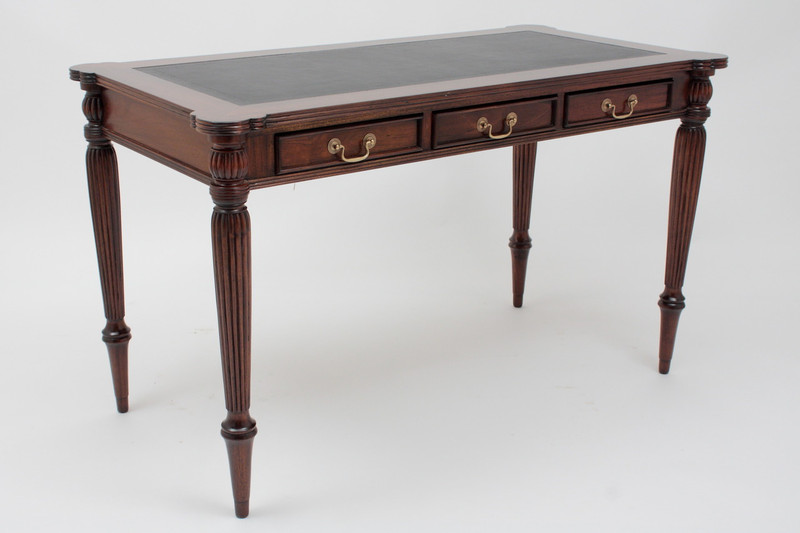- Home
- Learn About Antique Furniture and Reproductions
- Resources
- Woodworking Joint Types
Woodworking Joint Types

Types of Wooden Joints
-
Butt Joint: As its name implies, a butt joint is a joint in which one piece of wood butts into another piece of wood. A basic butt joint usually forms a right angle and is fastened using mechanical fasteners. This type of joint is most often used for wall framing, trimming, and baseboards. A mitered butt joint consists of cutting the ends of two pieces of wood on opposite angles, so they butt together to form what looks like a single piece that hides any end grain.
-
Lap Joint: A lap joint is a joint in which two pieces of wood overlap. With a full lap joint, one piece of wood overlaps the other and is fastened together using nails or screws. A notched lap joint, also known as a half-lap joint, is formed by overlapping two pieces so that they rest flush. A notched lap joint adds additional strength and the depth of the notch varies per project. Lap joints are ideal for structural framing or reinforcing wood that tends to sag or warp over time.
-
Tongue and Groove Joint: A tongue and groove joint, also known as an edge-to-edge joint, is a joint in which one piece of wood has a slot or groove cut all along one edge while the other piece of wood has a tongue cut on the mating edge. As a result, this joint allows two pieces of wood to fit together closely and is often used to make wide tabletops.
-
Mortise and Tenon Joint: A mortise and tenon joint is a traditional joint in which the end of one piece of wood is tapered in order to fit into the cavity carved into another piece of wood. To put it simply, the mortise is the cavity in one piece of wood and the tenon is the piece of wood that fits into the mortise. A tenon is usually smaller than it is wide. This simple yet strong joint is used to join perpendicular pieces, such as shelves or furniture legs for chairs and tables.
-
Biscuit Joint: A biscuit joint is much like the reinforced version of a butt joint with elements of the tenon and groove joint. This type of joint is used to join two pieces of wood along the edges using cut slots and beechwood wafers to hold the boards in place. Beechwood wafers, also known as biscuits, are small discs made of dried and compressed wood. This modern method is commonly used for creating tabletops and strengthening all different types of wooden joints.
-
Pocket Joint: A pocket joint is a type of joint in which a pocket hole is counterbored and a pilot hole is pre-drilled at an angle between two pieces of wood before connecting the two with a screw. This type of joint is common within cabinet making and in other applications where strength is necessary. Pre-drilling is usually accomplished by use of a jig.
-
Dado Joint: A dado joint is a joint in which a square-grooved slot is cut into the surface of a board so that another board will fit. A dado is similar to tongue and groove joinery and often used to make bookcase shelving or cabinetry.
-
Bridle Joint: Similar to mortise and tenon, a bridal joint consists of a tenon on the end of one piece of wood and a mortise in the other piece of wood. Where they differ is that the mortise in a bridle joint is cut to the full width of the tenon piece to create three gluing surfaces. Bridle joinery is often used to house railing and construct narrow frames.
-
Dovetail Joint: A dovetail joint is a classic type of joint that allows two pieces of wood to interlock using pins and tails. A through dovetail joint can be seen from all outside surfaces. A half-blind dovetail joint allows the front end of the board being attached to be hidden from view. A secret mitered dovetail conceals the joint from both the inside and outside corners. A sliding dovetail joins two pieces of wood at a right angle by sliding the tail of one piece into the socket of the other. Dovetail joinery is revered for its beauty and strength, making it suitable for high-end casegoods and furnishings.
-
Box Joint: A box joint looks quite like a dovetail, but its pins are square instead of angled. This square-shouldered joint connects two pieces of wood together at a right angle, relying on glue to hold the boards in place. Box joints, also known as finger joints, are commonly used to make boxes, crates, and chests.
Now that you know more about the different types of wooden joints, you will be able to identify the type of joinery used to make the furniture in your home and appreciate the level of craftsmanship put into every piece. At Laurel Crown, we specialize in building quality antique reproduction by hand using traditional construction and joinery techniques. We would be happy to learn what kind of furniture you are interested in designing for your home. Please contact us today!









